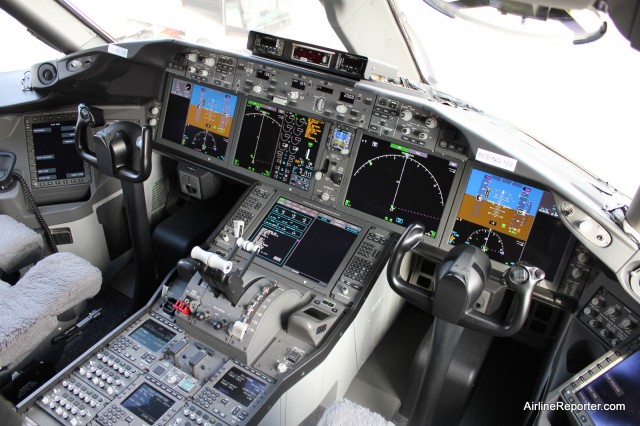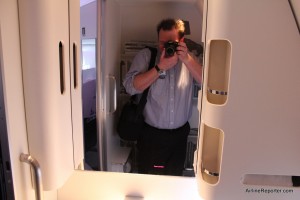
787 cockpit showing TCAS on the Multi-Function Display – Photo: AirlineReporter
A few months ago, a near-collision between two Boeing 757s off the coast of Hawaii was in the headlines. This event was particularly noteworthy because of the emergency descent made by United Airlines Flight 1205, which descended over 600 feet in a matter of seconds, terrifying passengers and sending items flying in the cabin. The pilots on the United flight were alerted to the oncoming traffic, and took action based on their Traffic Collision Avoidance System (TCAS).
History of mid-air incidents and TCAS mandate
Although TCAS systems are a (relatively) recent development in airline cockpits, the need for such systems was recognized long ago. On June 30,1956, a mid-air collision occurred at 20,000 feet between a United Airlines DC-7 and a TWA Lockheed 1049 over the Grand Canyon in northern Arizona. This incident, which resulted in 128 fatalities, served as a wake-up call for the aviation industry. Prior to the collision, ’œbig sky theory’ was the prevailing notion – that two aircraft flying in three-dimensional space were very unlikely to collide. Following this incident (which also led to the creation of the FAA), research began on developing collision avoidance systems.

Oh noes! Will AvGeeks be safe taking Laviator photos in the future? Taken on Air New Zealands Boeing 777-300ER
The Federal Aviation Administration ordered airlines to remove the oxygen tanks located in lavatories in 6000 aircraft across the United States. The FAA determined that someone could use the oxygen tanks to start a fire or to create a bomb. The Air Worthiness Directive 2011-04-09 stated that airlines had to comply over a 21-day period, ending on March 4th. The entire process was kept a secret to the general public, since the FAA did not want someone to use the information for evil doing.
This means that if cabin pressure is lost mid-flight, there would be no oxygen mask for a passenger in the bathroom. This has some people very upset (and afraid), but really flight attendants are trained to take care of you and although some people think depressurization happens all the time it is a very rare situation — especially when you think about how many flight hours are completed in the US on a daily basis. I would rather take the risk of being in the bathroom during decompression versus someone using the oxygen container for something bad.
So why have the bathroom oxygen tanks been removed, but not the others in the main cabin? I suspect the ones in the lavatories were targeted since passengers have a pretty high level of privacy and could barricade themselves in. The airlines and aircraft manufactures are working on a better solution (I am thinking an alarm to access the oxygen tank?), but there is no word when oxygen will be re-activated in the lavatories.
To learn more, check out my story on AOL Travel News (http://aol.it/ex6xq5).

